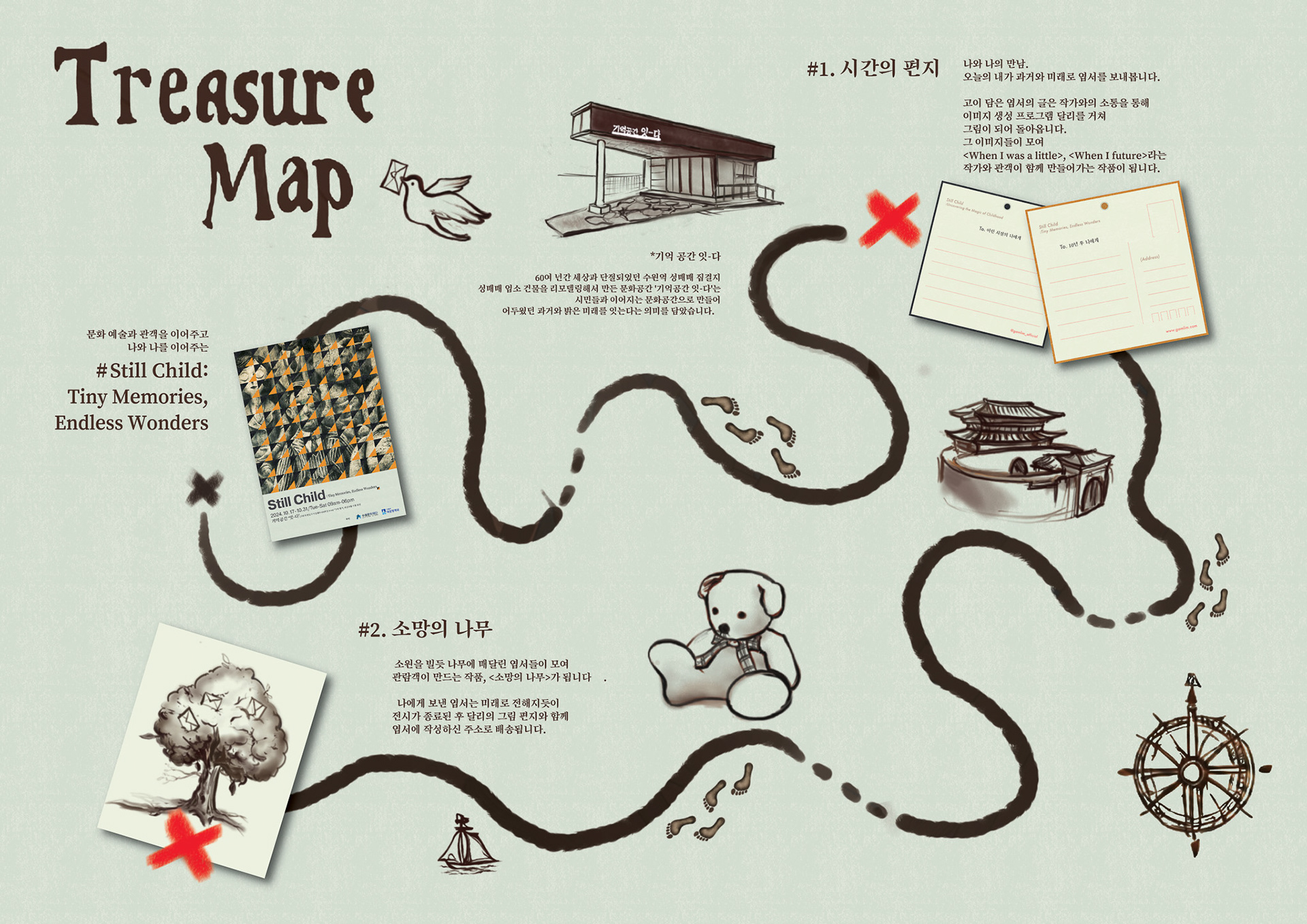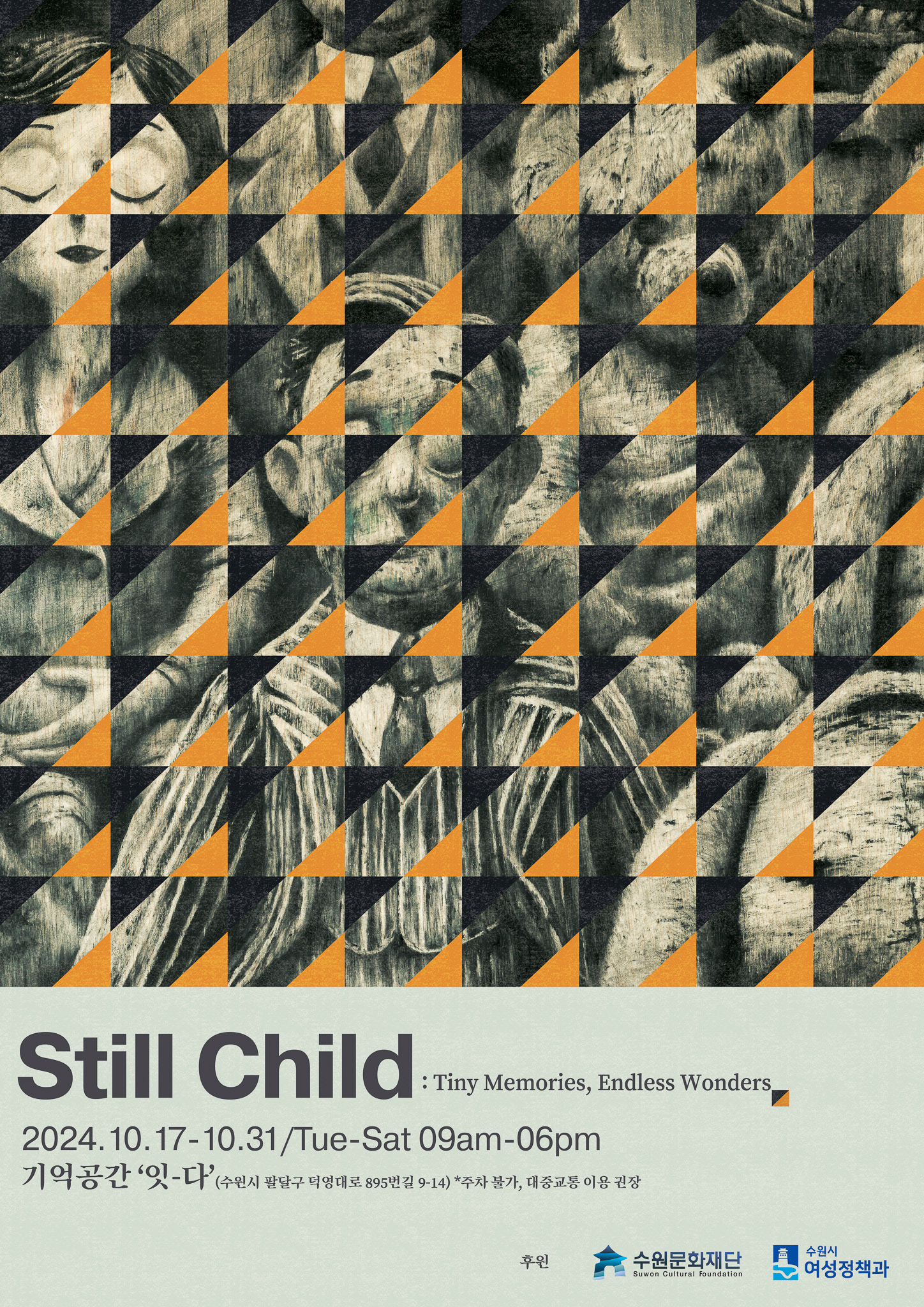“나는 이 전시 공간이 관객들에게 어린 시절의 나와 오늘의 내가 만나 서로를 이해하고, 또 이해받는 쉼을 제공하길 바란다. 전시장을 나설 때는 미래로 나아갈 힘찬 발걸음을 내딛을 수 있는 ‘휴식의 시간’이 되기를 희망한다.”
“전시 「Still Child」에서 오늘의 ‘나’를 마주하길 바랐다.” 홍단비 작가는 전시에 대해 이렇게 말했다. 전시 제목에서부터 ‘아이들’을 소재로 한 전시임이 여실히 드러난다. 어린아이는 순수한 잔혹함과 가슴 뛰는 상상들을 품고, 서툴지만 확실하고 미성숙하지만 자연스러웠다. 아직 아이, 자라버린 시간을 넘어 모두의 안에는 그 ‘아이’가 있다. 아이들이라는 소재로 작가는 작품들로 어른을 말하는 것이다. 과거를 그리고 있지만 현재를 바라보길 바라는 작가의 목소리이다.
지나간 시간 속에서 ‘아이’로 남아버린 것은 무엇일까? 바쁘게 살아가는 시간은 지나간 삶을 되돌아볼 여유를 주지 않는다. 그 지나간 시절에만 갖고 있던 바람들이 있지만, 묻어두고 포기하고 잊어버렸다. 어릴 땐 어려서 하지 못했던 말과 행동들, 아직 어려 쉽게 드러냈던 모습들. 어른이 되어 할 수 있게 된 것도 있지만 어른이기에 표현할 수 없는 것들이 생긴다. 겉으로는 타인의 눈치를 보고 안으로는 굳어버린 가치관이 많은 행동에 제약을 건다. 아이나 어른이나 같다. 아이 때도 자라버린 지금도 나다. 하고 싶었던 꿈들, 헤아림을 받지 못한 마음들, 순수한 열정을 불러오는 설렘들, 그들은 자라면서 ‘나’에게 여전한 ‘아이’로 남는다.
아이를 소재로 하고 있지만 그 아이들을 통해 인생을 말하고 싶었던 홍단비 작가는 그간 전시와 작품들에서도 삶을 이야기하고 그 과정을 대중에게 전해왔다. 그렇기에 작가는 언제나 ‘소통’이라는 부분에 많이 집중했다. 그중에서도 단연 이번 전시가 그 방향성을 가장 많이 드러나는 것을 볼 수 있다. ‘예술을 향유하는 관객’과 ‘전시를 기획한 작가’가 함께 만들어가는 작품인 《소망의 나무》를 통하여 작가와 관객은 자신의 이야기를 공유하고 소통하게 된다. 또한 관객의 참여로 이루어지고 완성되는 작품을 넘어, 전시 공간에 방문하여 느끼는 모든 것들 또한 작가가 바라는 작품이자 전시이다.
문화 예술에 대한 관심도가 점점 높아지고 있음에도 아직 ‘미술 작품’ 관람은 다른 문화 예술에 비해 낯설고 어렵다는 인식이 많은 편이다. 이것이 이번 「Still Child」가 익숙한 전시 형태를 벗어난 새로운 모습으로 기획된 이유이다. 홍단비 작가는 대중을 위한 예술을 만들어감에 있어서 작품의 내용도 중요하지만, 작품 감상 환경 또한 중요하다는 것을 이번 전시 기획을 통해 말하고 있다.
홍단비 작가에게 예술 세계를 이어감에 있어서 가장 중요한 키워드는 ‘대중’이다. 이 점이 홍단비 작가가 ‘기억공간-잇다’를 전시 장소로 선택한 이유이기도 하다. 수원의 어두웠던 과거의 자리에 시민과 예술을 이어주기 위한 전시관 ‘기억공간-잇다’가 대중과 예술을 잇고자 하는 작가의 의도와 맞아떨어졌다.
이곳에서 이루어지는 이번 「Still Child」 전시는 대중이, 작품 감상을 넘어 직접 작품을 만들어가는 참여 예술 작품과, 새로운 전시 형태를 통해 미술 작품 관람을 더 친근하게 느낄 수 있도록 안배된 전시이다. 전시관에 온 모든 걸음이 쉼을 얻고, 자신을 만나는 시간이 되기를 바라는 작가의 마음이 담겨있다. 이번 「Still Child」 전시를 통해 자신의 이야기를 예술 작품으로 담을 뿐 아니라, 쉼을 얻는 시간이 되기를 바란다.
“I hope this exhibition space offers audiences a ‘moment of rest’
where their childhood selves can meet their present selves,
allowing for understanding and connection,
so that when they leave, they can step confidently into the future.”
As you enter the exhibition hall, the playful curiosity of children unfolds like a living painting before your eyes. You’re greeted by familiar behaviors that might have colored many people’s childhoods, almost as if a child is stepping out to share a bright smile. “In the exhibition ‘Still Child,’ I wanted to confront ‘the present me’,” says artist Hong Danbi. From the very title, it’s clear that the exhibition revolves around the theme of childhood. Children carry a raw, innocent form of imagination that is both thrilling and unrefined, clumsy yet assured. Within each of us, that ‘child’ persists, transcending the passage of time. Through her works, the artist reflects on adulthood, inviting us to engage with the past while embracing the present.
What fragments of our childhood remain, even as we grow older? The busy pace of life often leaves little room for reflection. We may have had dreams unique to our younger selves, yet many have been buried, given up, or forgotten. There are unspoken words and unexpressed feelings from our youth, and moments of unguarded joy that still resonate within us. As adults, we gain certain freedoms but also face constraints that make expression harder. Our outward considerations of others and the rigid values we adopt can limit our actions. Whether child or adult, it is all the same, we remain fundamentally the same. The dreams we once cherished, the feelings left unrecognized, and the pure excitement that stirs our passion — they all reside within the ‘child’ in us, even as we grow.
While the exhibition focuses on children, Hong Danbi uses their experiences to explore the complexities of life. Through her previous exhibitions and works, she has consistently shared these themes with the public, emphasizing the importance of ‘communication.’ Among her works, exhibition particularly highlights that focus. Through ‘Tree of Hope’, a collaborative work created between the ‘art-loving audience’ and the ‘artist who envisioned the exhibition,’ both artist and audience share their stories and connect. Beyond just audience participation, every experience within the exhibition space reflects the artist’s vision for the work.
Despite the growing interest in cultural arts, many still find viewing ‘artworks’ unfamiliar and daunting compared to other forms of artistic expression. This is why ‘Still Child’ has been designed to break away from traditional exhibition formats. Hong Danbi highlights that while the content of artworks is vital, the environment in which they are experienced matters just as much. The key focus for her as she continues her artistic journey is ‘the public.’ This is why she chose ‘Memory Space - Connect’ as her exhibition venue. Located in a site marked by Suwon’s dark past, this exhibition hall embodies the artist’s intention to bridge the gap between the public and art.
The current ‘Still Child’ exhibition invites the audience to engage beyond mere appreciation, allowing them to create participatory art while experiencing a fresh approach to exhibitions. Every step taken within the exhibition hall reflects the artist’s hope for attendees to find solace and a moment for self-reflection. Through ‘Still Child,’ the goal is not only to capture personal stories in art but also to provide a restorative experience that empowers individuals.

